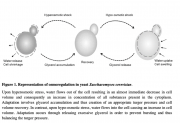Exam 2 study guide
Circuits
Solving circuits will not be not a major emphasis of exam 2. But that doesn’t mean you can totally forget about circuits All the topics from quiz 2 are fair game.
Things you should know:
- Ideal LSI circuit elements (R, L, C), symbols, constitutive equations
- Voltage/current conservation laws
- Series and parallel patterns
- Divider pattern
- Impedance
- Equivalent circuits
- First-order low- and high-pass filters
Signals and systems
- Transfer functions and Bode plots
- Cascade pattern; input and output impedance
- Second-order system
- Characteristic polynomial
- Damping ratio, undamped natural frequency, undamped natural frequency
- Equivalent representations of an LSI system
- Single differential equation
- Poles and zeros
- Coupled differential equations
Feedback systems
- Black’s formula
- Effect of gain on feedback response
- Root locus diagram
Mettetal paper
Simplified osmotic shock story
You should understand the basic story of how S. cerevisiae recovers from osmotic shock. You don’t need to memorize the specific proteins involved. The figure below is :

Key points (not all of which are in the Mettetal paper): • Osmosis is a thing: o The cell membrane is permeable to water, but not to most everything else. (Other molecules enter or leave the cell via membrane transport proteins.) o Water molecules move across the cell membrane in the direction from low to high osmotic concentration. o Osmotic pressure does not depend on the identity of the solute molecules – only their molar concentration. o Dictionary definition of osmosis: A process by which molecules of a solvent tend to pass through a semipermeable membrane from a less concentrated solution into a more concentrated one, thus equalizing the concentrations on each side of the membrane. • At equilibrium, glycerol leaves S. cerevisiae via a membrane transport channel. o The aquaglyceroporin Fps1 is maintained in open state by a protein called Rgc2 bound to its C-terminal. • Increasing the extracellular salt concentration causes water to leave the cell. o The cell shrinks and the hydrostatic pressure on the cell membrane decreases. • Osmosensor proteins detect reduced turgor pressure (the force from within the cell that pushes on the cell wall) and activate the mitogen-activated protein kinase (MAPK) Hog1. o The osmosensors activate two redundant signaling pathways. Both pathways converge on the MAPKK protein Pbs2. In other words, Pbs2 activates Hog1. • Activated Hog1 initiates a variety of actions that increase the glycerol concentration in the cell o Hog1 stops glycerol efflux by phosphorylating/evicting Rgc2 from Fps1. o Activated Hog1 enters the nucleus, where it upregulates two proteins involved in the production of glycerol, Gpd1 and Gpp2 (among other things such as arresting the cell cycle and upregulating Stl1) • Hog1 gets deactivated in the nucleus and exported to the cytoplasm Yeast lab Activated Hog1 enters the nucleus. • “We applied system identification methods to infer a concise predictive model.” • “We found that the dynamics of the osmo-adaptation response are dominated by a fast-acting negative feedback through the kinase Hog1 that does not require protein synthesis.”
Cite error: <ref> tags exist, but no <references/> tag was found
